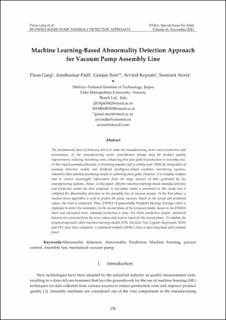| dc.contributor.author | Garg, Paras | |
| dc.contributor.author | Patil, Amitkumar | |
| dc.contributor.author | Soni, Gunjan | |
| dc.contributor.author | Keprate, Arvind | |
| dc.contributor.author | Arora, Seemant | |
| dc.date.accessioned | 2022-03-09T08:26:00Z | |
| dc.date.available | 2022-03-09T08:26:00Z | |
| dc.date.created | 2021-11-30T00:04:31Z | |
| dc.date.issued | 2021-11-04 | |
| dc.identifier.citation | Reliability: Theory & Applications. 2021, 16 176-187. | en_US |
| dc.identifier.issn | 1932-2321 | |
| dc.identifier.uri | https://hdl.handle.net/11250/2983884 | |
| dc.description.abstract | The fundamental basis of Industry 4.0 is to make the manufacturing sector more productive and autonomous. In the manufacturing sector, practitioners always long for product quality improvement, reducing reworking costs, enhancing first pass yield in production or assembly line, in this regard anomaly detection, is becoming popular and is widely used. With the integration of anomaly detection models and Artificial Intelligence-based condition monitoring systems, industries have attained promising results in achieving these goals. However, it is a highly complex task to extract meaningful information from the large amount of data generated by the manufacturing systems. Hence, in this paper, effective machine-learning-based anomaly detection and prediction model has been proposed. A two-phase model is presented in this study and is validated for abnormality detection in the assembly line of vacuum pumps. In the first phase, a random forest algorithm is used to predict the pump vacuum. Based on the actual and predicted values, the error is computed. Then, EWMA (Exponentially Weighted Moving Average) chart is employed to detect the anomalies. In the second phase of the proposed model, based on the EWMA chart and calculated error, anomaly prediction is done. For better prediction results, statistical features are extracted from the error values and used as input for the second phase. To validate the proposed approach, other machine learning models SVR, Decision Tree, Logistic Regression, KNN and SVC have been compared. A statistical method EWMA chart is also integrated with random forest. | en_US |
| dc.language.iso | eng | en_US |
| dc.publisher | Gnedenko Forum | en_US |
| dc.relation.ispartofseries | Reliability: Theory & Applications;Special Issue No 2(64), Volume 16, November 2021 | |
| dc.rights | Navngivelse 4.0 Internasjonal | * |
| dc.rights.uri | http://creativecommons.org/licenses/by/4.0/deed.no | * |
| dc.subject | Abnormality detection | en_US |
| dc.subject | Abnormality predictions | en_US |
| dc.subject | Machine learning | en_US |
| dc.subject | Process controls | en_US |
| dc.subject | Assembly lines | en_US |
| dc.subject | Mechanical vacuum pumps | en_US |
| dc.title | Machine learning-based abnormality detection approach for vacuum pump assembly line | en_US |
| dc.type | Peer reviewed | en_US |
| dc.type | Journal article | en_US |
| dc.description.version | publishedVersion | en_US |
| cristin.ispublished | true | |
| cristin.fulltext | postprint | |
| cristin.qualitycode | 1 | |
| dc.identifier.doi | https://doi.org/10.24412/1932-2321-2021-264-176-187 | |
| dc.identifier.cristin | 1961296 | |
| dc.source.journal | Reliability: Theory & Applications | en_US |
| dc.source.volume | 16 | en_US |
| dc.source.issue | 2 | en_US |
| dc.source.pagenumber | 176-187 | en_US |

